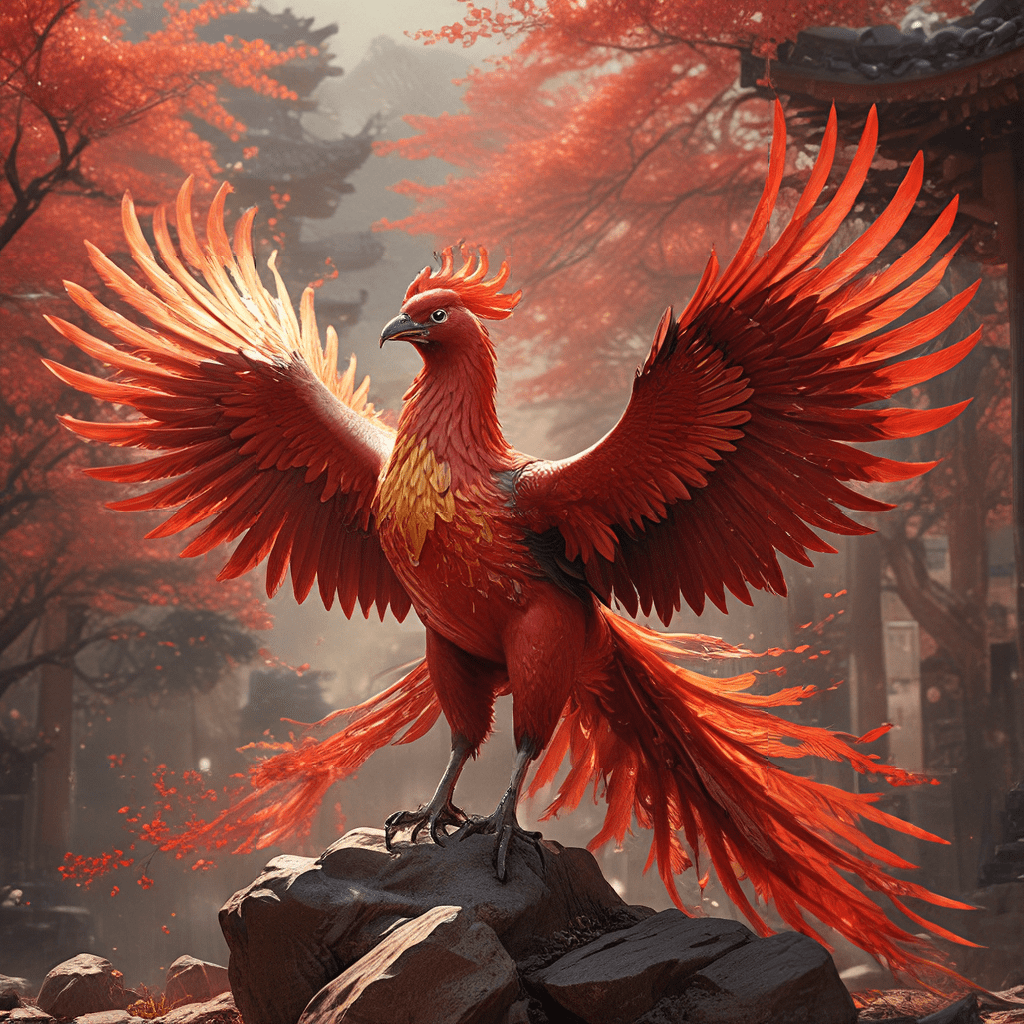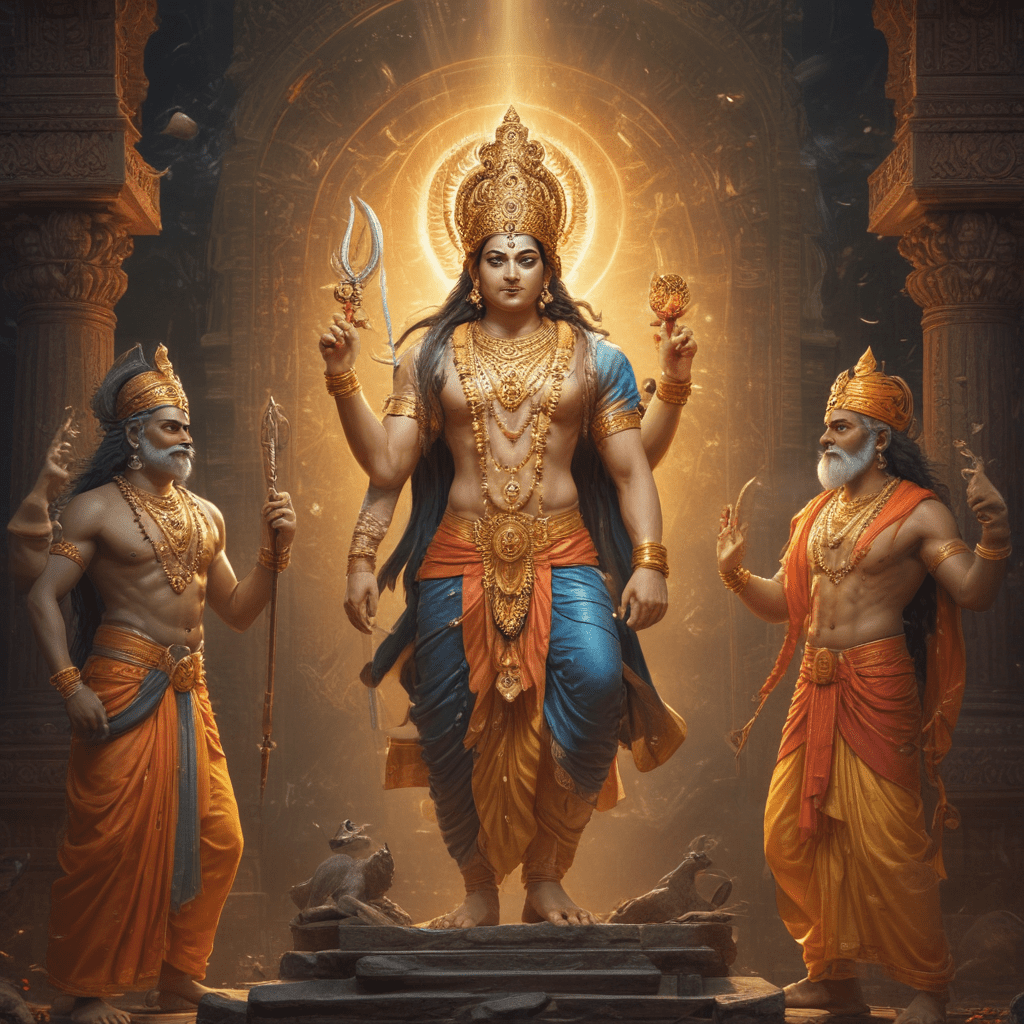The Red Phoenix in Korean Mythology: A Symbol of Rebirth and Renewal
In the rich tapestry of Korean mythology, the Red Phoenix, known as "Ju-Jo" in Korean, holds a prominent place as a powerful symbol of rebirth, renewal, and the cyclical nature of life. Ju-Jo is a majestic creature with fiery red plumage, a long, graceful tail, and a piercing gaze. It is often depicted with a single, sharp claw on its feet, symbolizing its connection to the Earth. Ju-Jo is a creature of immense power and beauty, embodying the essence of the sun, fire, and the cyclical nature of life, death, and rebirth.
The Red Phoenix is more than just a mythical creature; it is an embodiment of vital life force, resilience, and the power of transformation. This mystical being represents the ability to rise above adversity, overcome challenges, and emerge stronger and more vibrant than before. The Red Phoenix’s legend holds symbolic meaning for the Korean people, acting as a reminder of their own strength and ability to endure hardship.
The Legend of the Red Phoenix: A Tale of Transformation and Power
One well-known legend tells of a phoenix named Ju-Jo who was born from the flames of a burning forest. The forest fire, while devastating, ultimately gave way to new life. Ju-Jo, with its vibrant red feathers, emerged from the ashes, symbolizing the cycle of destruction and renewal.
As the phoenix lived, its feathers grew duller until, at the end of its life, it built a nest of fragrant herbs and spices and set itself ablaze. From the ashes, a new phoenix emerged, young and vibrant, carrying with it the spirit of its predecessor. This cycle of self-immolation and rebirth is a powerful metaphor for the continuous cycle of life, death, and resurrection that exists in nature and, by extension, within human lives.
Origins and Symbolism of the Red Phoenix
The Red Phoenix is a complex symbol, drawing on ancient beliefs about the power of fire and the cyclical nature of life. The phoenix, as we know it today, has its roots in ancient Egyptian mythology, where it was known as the Bennu. The Bennu was associated with the sun god Ra and symbolized the rebirth of the sun each morning.
The Red Phoenix in Korean mythology shares many similarities with its Egyptian counterpart but takes on a distinct Korean identity, reflecting the cultural and philosophical values of the Korean people. The Red Phoenix embodies the resilience of the Korean spirit, their ability to overcome hardship and emerge stronger. It symbolizes the enduring power of life, the cycle of renewal, and the promise of a new beginning.
The Red Phoenix as a Divine Being: Embodiment of Fire, Light, and the Sun
In Korean mythology, the Red Phoenix is often depicted as a divine being, associated with fire, light, and the sun. Its fiery plumage, the source of its immense power, represents the transformative force of fire, the power to purify and renew. The sun, as a source of life and energy, is another important symbol associated with the Red Phoenix, reflecting the power of light to guide and illuminate.
The Red Phoenix's ability to rise from the ashes symbolizes the power of the sun to rise each morning, bringing hope and renewal. Its connection to fire and the sun reinforces its role as a powerful symbol of rebirth and transformation, a reminder of the enduring cycle of life, death, and renewal.
The Phoenix in Korean Folklore: Beyond the Realm of Mythology
The Red Phoenix is not limited to the realm of mythology, but is also found in Korean folklore and legends. In folklore, the Red Phoenix is sometimes depicted as a messenger between the human world and the divine realm. People might pray to the Red Phoenix for guidance, protection, and good fortune, believing it to be a powerful being who could intercede on their behalf.
The Red Phoenix’s appearance is often associated with positive events, such as the birth of a child or the arrival of good fortune. The Red Phoenix, in Korean folklore, is a symbol of hope and renewal, representing the powerful connection between humanity and the divine, and the possibility of good fortune and prosperity.
The Red Phoenix in Korean Art and Literature: Depictions of its Mystical Nature
The Red Phoenix, with its dazzling beauty and symbolic power, has captured the imaginations of Korean artists and writers for centuries. Many works of art feature the Red Phoenix in vivid detail, showcasing its vibrant plumage, its graceful movements, and its connection to fire and light. These depictions, often found in traditional Korean paintings, sculptures, and decorative arts, reveal the Red Phoenix's importance to Korean culture and its enduring place in the national consciousness.
In Korean literature, the Red Phoenix is also a recurring theme, appearing in traditional poetry, folk tales, and modern novels. These works often use the Red Phoenix as a symbol of hope, renewal, and the enduring power of the human spirit. In traditional poetry, the Red Phoenix's beauty and power have been praised for its ability to inspire hope and wonder. The Red Phoenix, in Korean literature, is often associated with themes of resilience, transformation, and the ability of life to overcome hardship and emerge anew.
The Red Phoenix as a Symbol of the Cycle of Life, Death, and Rebirth
The Red Phoenix's ability to rise from the ashes after self-immolation is a powerful symbol of the cycle of life, death, and rebirth. This cycle is a fundamental aspect of nature, and the Red Phoenix embodies it in a way that is both beautiful and awe-inspiring. It represents the essential truth that life is a constant process of change and renewal, that even in the face of destruction, there is always the possibility of new beginnings.
The Red Phoenix's self-immolation is not a senseless act of destruction but a purposeful act of transformation. By burning itself, the Red Phoenix releases its old form and allows a new, vibrant life to emerge from the ashes. This cycle of life, death, and rebirth is a powerful reminder that endings are not the end, but rather, the beginning of something new. The Red Phoenix encourages us to embrace change and to see destruction as an opportunity for transformation.
The Red Phoenix as a Source of Inspiration and Hope
The Red Phoenix, with its capacity for rebirth and renewal, is a source of inspiration and hope for many people. Its power to rise from the ashes symbolizes the human capacity for resilience and the ability to overcome adversity. The Red Phoenix's story reminds us that even in the face of great challenges, there is always the potential for new beginnings. It inspires us to persevere through difficult times and to embrace the possibility of a brighter future.
The Red Phoenix's legend serves as a reminder that even in the darkest of times, there is always the potential for light to emerge. Its story offers a sense of hope and a belief in the possibility of change and transformation. It encourages us to see life as a journey of renewal and growth, and to embrace the challenges and opportunities that come our way with courage and optimism.
Theoretical Interpretations of the Red Phoenix Legend: A Reflection of Korean Beliefs and Values
The Red Phoenix legend is a rich source of information about Korean beliefs and values. It reflects the importance of balance, harmony, and the cyclical nature of life in Korean culture. The Red Phoenix's ability to rise from the ashes symbolizes the Korean belief in the importance of resilience and the ability to overcome adversity.
The Red Phoenix's association with the sun and fire reflects the importance of light, energy, and renewal in Korean culture. The sun is seen as a source of life and energy, and fire is seen as a transformative force that can purify and renew. The Red Phoenix's legend embodies the Korean belief in the cyclical nature of life, the importance of change and transformation, and the ability of new life to emerge from destruction.
The Red Phoenix: A Timeless Symbol of Change, Resilience, and the Promise of a New Beginning
The Red Phoenix is a timeless symbol that continues to resonate with people around the world. It represents the power of change, the importance of resilience, and the promise of a new beginning. The Red Phoenix's legend serves as a reminder that life is a continuous cycle of renewal and transformation, and that even in the face of adversity, there is always hope for a brighter future.
The Red Phoenix's story is a source of inspiration and hope, reminding us that we too have the capacity to rise from the ashes and create a new beginning for ourselves and for the world around us. The Red Phoenix, in all its vibrant splendor, reminds us that change is a natural part of life, and that we have the power to embrace it and emerge stronger and more vibrant than before.
Frequently Asked Questions about the Red Phoenix
Q: What is the Red Phoenix's role in Korean mythology?
A: The Red Phoenix, or Ju-Jo, is a powerful symbol of rebirth, renewal, and the cyclical nature of life. It represents the ability to rise above adversity and emerge stronger.
Q: What is the significance of the Red Phoenix's fiery plumage?
A: The fiery plumage symbolizes the transformative force of fire, its power to purify and renew, and its association with the sun as a source of life and energy.
Q: How is the Red Phoenix depicted in Korean art and literature?
A: The Red Phoenix is frequently featured in traditional Korean paintings, sculptures, and decorative arts, often showcasing its vibrant plumage, its graceful movements, and its connection to fire and light. It also appears in Korean literature as a symbol of hope, renewal, and the enduring power of the human spirit.
Q: What are some theoretical interpretations of the Red Phoenix legend?
A: The legend reflects the importance of balance, harmony, and the cyclical nature of life in Korean culture. It also symbolizes the Korean values of resilience and the ability to overcome adversity.
Q: What does the Red Phoenix's legend teach us about life?
**A: **The legend teaches us that life is a continuous cycle of renewal and transformation. It also emphasizes the importance of resilience and the power of new beginnings.



